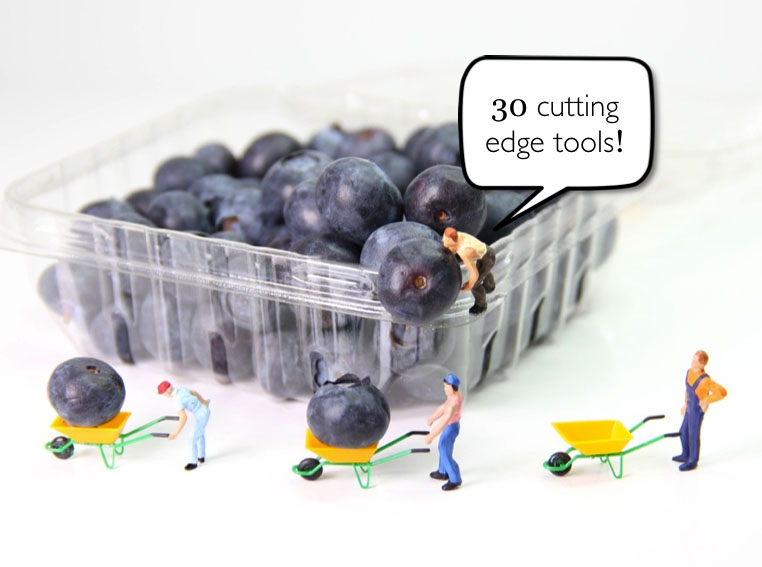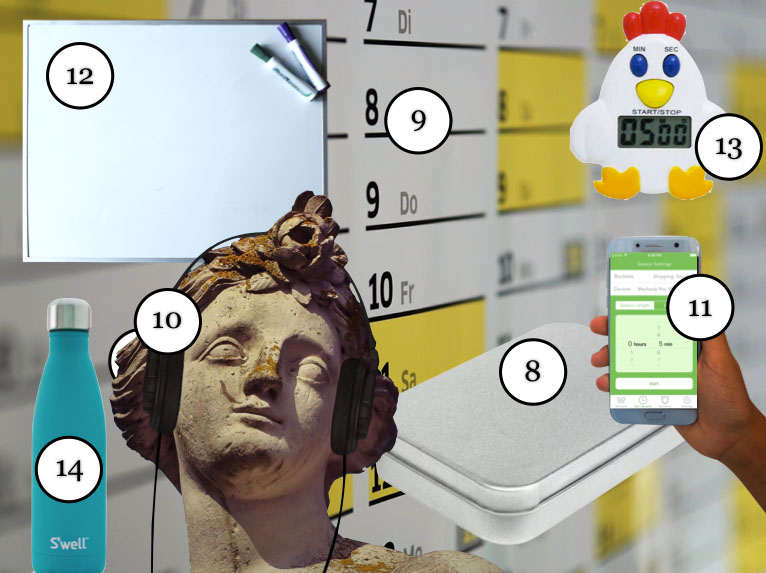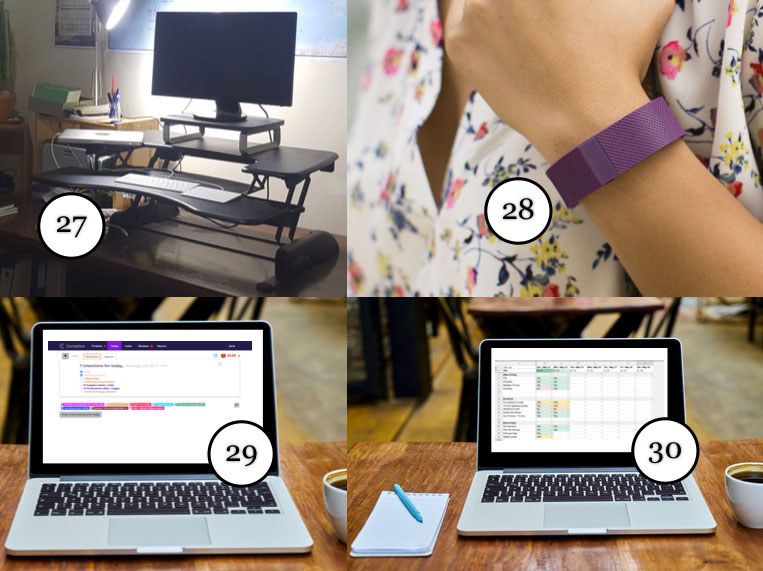There is a good chance your back to school list doesn’t state a blender, whiteboard or crazy Japanese post-it notes.
But I’m suggesting that you seriously consider adding these items to your back to school list.
Why?
Because they will make you feel good. They’ll help you to have more fun with your studies.
Because let’s face it, when you’re having fun and feeling good, chances are you’ll be learning more than someone who is hangry, grumpy or in a stinker of a mood.
It’s your call. Your choice. Because you do have a choice when it comes to what you do and how you feel.
The tools
I’ve grouped the tools into five categories:
1. Work tools
2. Productivity tools
3. Self care tools
4. Peace of mind tools
5. Advanced level tools
If you were going to invest in only five tools, these would be my top five picks:
Tools #1, #10, #14, #17 and #19.
So here is my list of tools …
Work tools
1. A good pen
Yes I know you’ve probably got pens on your back to school list. But I’m not just talking about any old pen here. I’m talking about a good quality pen.
Don’t use a cheap pen that makes you angry. Make the writing process as pleasurable as possible by investing in a pen that feels good in your hand.
2. A notebook
Sometimes you need to get away from screens and the world of distractions that come with them. Work with pens and paper.
3. Coloured pens
Struggling to study a boring topic? Then take out some coloured pens. A few colours on the page can keep your brain engaged for much longer. They’ll also help you to create solid mind maps.
4. Post-it notes
I’m a little obsessed with post-it notes, especially crazy, colourful ones from Japan. With these fun little tabs, you can tag key ideas and write yourself reminders.
5. Comfortable shoes and socks
I have a rule: if I have to use something for more than an hour a day, then I always buy the best quality that I can afford.
Don’t go cheap with your shoes and socks. Buy the most comfortable shoes and socks that you can afford. When your feet feel good, you feel good.
6. A workspace that works for you
Okay, technically this is not one specific tool. It’s a combination of tools. If you don’t have a desk, go get one. Consider getting a standing desk (tool #27).
Your environment affects how you feel. Since you’re going to be spending a fair chunk of time studying, you might as well enjoy being in your workspace. Adjust the decor (e.g. tools #9, #12 and #18), lighting and sounds to suit your needs.
7. A book on a topic that interests you
Become a member of your local library (it’s free) and take out a book that interests you on a topic that is completely unrelated to your school subjects (e.g. Greek mythology, activism, quantum physics).
If you’re feeling bogged down and lost in your schoolwork, pick up this book for a bit of relief. This book is a reminder that learning can be fun.
Productivity tools
8. A basket or box for your phone
If you want to improve your focus by 100% when you study, implement one simple strategy: don’t have your phone next to you.
Place your phone in a box or basket in another room. Out of sight is out of mind. Your phone is out of bounds until you finish doing what you need to do.
9. Yearly wall planner
Have a tendency to leave your work until the last minute? Underestimate how long you have to complete certain tasks? This is where a yearly wall planner comes in handy.
In one glance you can see what is coming up. You can pinpoint busy periods and prepare yourself. I look at intense periods and say “Let’s do a little prep work now to make it less stressful in the future”.
10. Headphones or noise blocking ear muffs
These have special powers:
Power #1: They signal to others “I’m busy working! Leave me alone!”*
Power #2: You can listen to music to help you relax and concentrate.
Power #3: They block out external noise and help you to stay focused.
Check out this article on Whirlpool for headphone recommendations at different price points.
*Note: This power only works if you don’t wear them all the time.
11. An Internet blocker app
Most people spend between 6-12 hours a week on social media. Think about what else you could be doing with that time?
Internet blocker apps like Freedom can help you regain control of technology. You can set it up to automatically lock you out of social media at set times or you can activate it before you start a study session (tip: I recommend automating your blocker app).
12. Whiteboard and markers
When you’re stuck on a problem or need to plan a project, whiteboards are your friend. The whiteboard is a fabulous tool for getting everything out of your head and capturing ideas. This is why I have whiteboards and markers in multiple locations in my house.
13. An electronic timer
An electronic timer can help you stay on task, track how long you’ve been working for and ensure your 5 minute break doesn’t turn into a 2 hour break.
Wondering why you can’t just use the timer on your phone? See tool #8.
14. Reusable drink bottle
Drinking water helps you to stay focused, alert and mentally sharp. But most of us don’t drink enough water. If you have a reusable drink bottle within arms reach, you’re more likely to drink from it. It’s as simple as that.
Self care tools
15. Containers for snacks
Healthy snacks help you get through the day (click here for snack ideas). They fill you up so you’re less likely to binge on junk food. Invest in some good containers to carry your snacks in. I like containers with multiple compartments that can slide easily into my bag.
16. Power nap mask
Napping isn’t just for kids. Research shows a short 15-30 minute nap can increase your ability to focus, lift your mood, improve your performance and decreases stress levels.
Sure, you can nap without an eye mask but I find a good light blocking eye mask makes the world of difference to the quality of my naps (see my review of various light blockers here). A low cost alternative is a scarf or a large, clean sock.
17. Old school alarm clock
If you’re waking up throughout the night to check your phone, then you’re probably not getting good, restorative sleep.
When you sleep next to your phone, it’s like having a bucket of hot chips or a giant doughnut right next to you. It’s hard to resist.
So don’t rely on your willpower reserves. Remove your phone and any other tempting devices from your bedroom. Start using an old fashioned alarm clock.
18. Indoor plants
A simple pot plant can beautify your study space and mop up any nasty chemicals in your home. Good indoor plants include Mother in Laws Tongue, Areca Palm and Money Plant.
19. A blender
Smoothies are the easiest way to eat more plants and fuel your brain with the nutrients it needs to learn. Throw some basic ingredients in a blender (e.g. banana, plant-based milk, berries, spinach, almonds, cacao and flaxseed), press a button and you’re done!
20. Fruit bowl
If fruit is tucked away at the back of your fridge, chances are you’ll forget about it. So here’s a tip from environmental design 101: invest in a funky fruit bowl and put some fruit in it close to your desk. You’ll be more likely to reach for a banana or peach instead of a packet of chips.
21. A good supportive pillow
If your pillow is flat like a pancake (i.e. it is no longer supporting your head or neck), you need to spend some time in a bedding store. Go test out the different pillows on offer. Do not rush this process. I repeat: Do not rush this process. Take as long as you need. Even consider taking a power nap in the store (see tool #16).
A word of warning: The most expensive pillow isn’t necessarily the best one to buy. Go with what feels good for you.
22. Dark chocolate
Keep a stash of dark chocolate in your pantry (80% or more cacao content). One square of dark chocolate can lift your mood and boost your brainpower. But if you’re not keen on dark chocolate, then try …
23. Berries
You want to put these in your blender when you’re making a smoothie or just eat them by the handful. Packed full of flavonoids, berries are fantastic for your brain and learning. I try to eat a cup of them every day (either fresh or frozen). Read more about the brain boosting benefits of berries here.
Peace of mind tools
24. Backup device
Hard drives die. Laptops get stolen. Spend 5 minutes every week backing up your work. Avoid the possibility of losing all your work and having a massive panic attack. Trust me on this. Just do it.
25. Worry pad
Worrying about something doesn’t actually make it better. It won’t make the problem magically disappear. Worrying just makes you feel bad.
So try this: Dump your worries into a notepad. Set a time later in the day to look over your worries (Worry o’clock). At Worry o’clock you can brainstorm actions you can take to alleviate your anxiety.
26. Gratitude journal
Research shows people who practice gratitude on a regular basis are more open and receptive to learning, do more physical exercise and have better psychological wellbeing.
This is why I recommend keeping a gratitude journal. I use The 5 Minute Journal. But a cheap $1 notebook will do the job for jotting down your daily blessings.
You don’t need anything fancy. But you do need to be consistent with your practice to experience the benefits.
Advanced level tools
27. Standing desk
I know these aren’t cheap but they are totally worth it.
One study found that if you simply stand at a desk for 3-4 hours per day instead of sit for a year, you’ll burn the same amount of calories as running 10 marathons.
I’ve been using a standing desk for several years now. I have to say I feel more alert, focused and energised when I’m working on my feet. And an extra bonus is my posture has improved, too!
You can read more about how I cultivated the habit of standing when I work here.
28. Fitness tracker
A fitness tracker can give you a good dose of reality. It can tell you, “Hey! You’re not moving enough buddy! Get off your butt and move it!” Thought you were doing 10,000+ steps but it turns out you’re only doing 2,500? The data can help you course correct.
29. Complice
This is a fantastic online tool for setting your daily intentions/goals, helping you stay on track and review your day/month. My output has at least doubled since using it.
30. Lights spreadsheet
Another great system that helps you track behaviours you want to turn into habits and keep yourself accountable. It’s free to download but like any tool, you need to be disciplined enough to look at it and use it everyday.
To sum up
Don’t have all of these items? No problem! Start by gathering what you’ve already got. Then see what you can get for free off your local Buy Nothing New Group (e.g. fitness tracker, blender and desk). You can also check out Gumtree for some bargains. Slowly build your toolkit.
All of these tools are designed to make micro-improvements in various areas of your life. And you’ll be surprised how a few simple improvements can make a big difference to the quality of your study experience.







3 thoughts on “The Ultimate Back to School List: 30 Essential Tools to Give You the Edge”
I totally love the idea of whiteboards and pens. Going to see if I can find some cheap ones for sale online 🙂
I gathered all the items with gratitude Journal. I love all the tools. Fitness tracker helps me.
I think you missed ONE thing.. scissors.
Comments are closed.